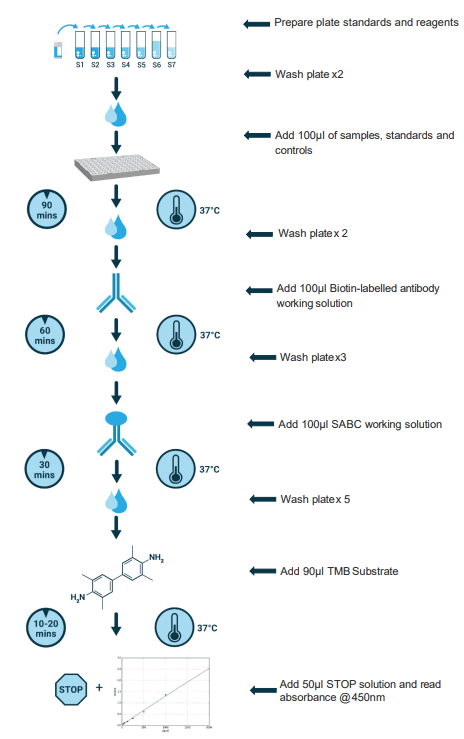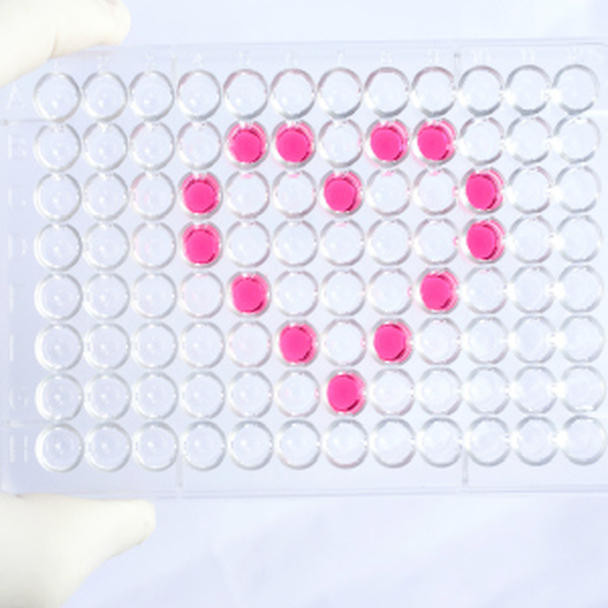Description
Assay Genie Human SPRED3 ELISA Kit
The Assay Genie Human SPRED3 ELISA Kit can assay for Human SPRED3 in the following samples: serum, plasma, tissue homogenates, cell culture supernates and other biological fluids.
How do our Human SPRED3 ELISA Kits work?
The Assay Genie Human SPRED3 ELISA Kits are designed for the quantitative measurement of analytes in a wide variety of samples. As today's scientists demand high quality consistent data for high impact journals, Assay Genie have developed a range of sensitive, fast and reliable ELISA kit assays to meet and exceed those demands. Our assay kits use a quantitative sandwich ELISA technique and each kit comes with highly specific antibodies pre-coated onto a 96-well microtiter plate.
At Assay Genie we understand the need for speed! Therefore, we have developed an ultra-fast protocol meaning you achieve your results rapidly. So, once you have prepared and plated your samples, blanks and standards, you simply incubate with a highly specific biotin-conjugated primary antibody and Avidin conjugated to Horseradish Peroxidase (HRP) and incubate for the appropriate length of time. After washing the plate according to the protocol and addition of the TMB (3,3',5,5'-Tetramethylbenzidine) solution, the appearance of a blue colour should be detected due to an enzymatic reaction catalysed by HRP. Next step is the addition of the Stop Solution which terminates the HRP reaction and the blue colour turns yellow with the signal intensity measured on a plate reader at 450nm. The amount of bound Human SPRED3 is proportional to the signal generated by the reaction meaning the Human SPRED3 ELISA Kit assay gives you a quantitative measurement of the analyte in your samples.
| Gene Name: | SPRED3 |
| Synonyms: | Spred-3, EVE-3 |
| Assay Type: | Sandwich |
| Detection Range: | 0.78-50ng/mL |
| Sensitivity: | 0.41ng/mL |
| Sample Type: | Serum, plasma, tissue homogenates, cell culture supernates and other biological fluids |
Human SPRED3 ELISA Kit Protocol
The below protocol is a sample protocol for Human SPRED3 ELISA Kit using a biotinylated detection antibody and streptavidin-HRP. Sandwich ELISAs allow for the detection and quantification of an analyte in a sample by using known analyte concentrations as standards and plotting absorbance of known concentrations vs known standard concentrations. This allows the researcher to calculate the amount of Human SPRED3 present in their sample.
Allow all reagents to reach room temperature (Please do not dissolve the reagents at 37°C directly). All the reagents should be mixed thoroughly by gently swirling beforepipetting. Avoid foaming. Keep appropriate numbers of strips for 1 experiment and removeextra strips from microtiter plate. Removed strips should be resealed and stored at -20°C untilthe kits expiry date. Prepare all reagents, working standards and samples as directed in theprevious sections. Please predict the concentration before assaying. If values for these arenot within the range of the standard curve, users must determine the optimal sample dilutionsfor their experiments. We recommend running all samples in duplicate.
Sandwich Protocol

Kit Protocol:
| 1. | Add Sample: Add 100µL of Standard, Blank, or Sample per well. The blank well is addedwith Sample diluent. Solutions are added to the bottom of micro ELISA plate well, avoid insidewall touching and foaming as possible. Mix it gently. Cover the plate with sealer we provided.Incubate for 120 minutes at 37?C. |
| 2. | Remove the liquid from each well, don't wash. Add 100µL ofDetection Reagent A working solution to each well. Cover with the Plate sealer. Gently tap theplate to ensure thorough mixing. Incubate for 1 hour at 37°C. Note: if Detection Reagent Aappears cloudy warm to room temperature until solution is uniform. |
| 3. | Aspirate each well and wash, repeating the process three times. Wash by fillingeach well with Wash Buffer (approximately 400µL) (a squirt bottle, multi-channel pipette,manifold dispenser or automated washer are needed). Complete removal of liquid at eachstep is essential. After the last wash, completely remove remaining Wash Buffer by aspiratingor decanting. Invert the plate and pat it against thick clean absorbent paper. |
| 4. | Add 100µL of Detection Reagent B working solution to each well.Cover with the Plate sealer. Incubate for 60 minutes at 37°C. |
| 5. | Repeat the wash process for five times as conducted in step 3. |
| 6. | Add 90µL of Substrate Solution to each well. Cover with a new Plate sealerand incubate for 10-20 minutes at 37°C. Protect the plate from light. The reaction time can beshortened or extended according to the actual color change, but this should not exceed morethan 30 minutes. When apparent gradient appears in standard wells, user should terminatethe reaction. |
| 7. | Add 50µL of Stop Solution to each well. If color change does not appear uniform,gently tap the plate to ensure thorough mixing. |
| 8. | Determine the optical density (OD value) of each well at once, using amicro-plate reader set to 450 nm. User should open the micro-plate reader in advance, preheatthe instrument, and set the testing parameters. |
| 9. | After experiment, store all reagents according to the specified storage temperaturerespectively until their expiry. |
Human SPRED3 ELISA Kit components | 96 Assays | Storage |
| ELISA Microplate(Dismountable) | 8×12 strips | -20°C |
| Lyophilized Standard | 2 | -20°C |
| Sample Diluent | 20ml | -20°C |
| Assay Diluent A | 10mL | -20°C |
| Assay Diluent B | 10ml | -20°C |
| Detection Reagent A | 120ul | -20°C |
| Detection Reagent B | 120ul | -20°C |
| Wash Buffer | 30ml | 4°C |
| Substrate | 10ml | 4°C |
| Stop Solution | 10ml | 4°C |
| Plate Sealer | 5 | - |
Other materials and equipment required:
The Assay Genie Human SPRED3 ELISA Kit will require other equipment and materials to carry out the assay. Please see list below for further details.
- Microplate reader with 450 nm wavelength filter
- Multichannel Pipette, Pipette, microcentrifuge tubes and disposable pipette tips
- Incubator
- Deionized or distilled water
- Absorbent paper
- Buffer resevoir
Sample Preparation
When carrying out an ELISA assay it is important to prepare your samples in order to achieve the best possible results. Below we have a list of procedures for the preparation of samples for different sample types.
| Sample Type | Protocol |
Serum | If using serum separator tubes, allow samples to clot for 30 minutes at room temperature. Centrifuge for 10 minutes at 1,000x g. Collect the serum fraction and assay promptly or aliquot and store the samples at -80°C. Avoid multiple freeze-thaw cycles. If serum separator tubes are not being used, allow samples to clot overnight at 2-8°C. Centrifuge for 10 minutes at 1,000x g. Remove serum and assay promptly or aliquot and store the samples at -80°C. Avoid multiple freeze-thaw cycles. |
Plasma | Collect plasma using EDTA or heparin as an anticoagulant. Centrifuge samples at 4°C for 15 mins at 1000 × g within 30 mins of collection. Collect the plasma fraction and assay promptly or aliquot and store the samples at -80°C. Avoid multiple freeze-thaw cycles. Note: Over haemolysed samples are not suitable for use with this kit. |
Urine & Cerebrospinal Fluid | Collect the urine (mid-stream) in a sterile container, centrifuge for 20 mins at 2000-3000 rpm. Remove supernatant and assay immediately. If any precipitation is detected, repeat the centrifugation step. A similar protocol can be used for cerebrospinal fluid. |
Cell culture supernatant | Collect the cell culture media by pipette, followed by centrifugation at 4°C for 20 mins at 1500 rpm. Collect the clear supernatant and assay immediately. |
Cell lysates | Solubilize cells in lysis buffer and allow to sit on ice for 30 minutes. Centrifuge tubes at 14,000 x g for 5 minutes to remove insoluble material. Aliquot the supernatant into a new tube and discard the remaining whole cell extract. Quantify total protein concentration using a total protein assay. Assay immediately or aliquot and store at ≤ -20 °C. |
Tissue homogenates | The preparation of tissue homogenates will vary depending upon tissue type. Rinse tissue with 1X PBS to remove excess blood & homogenize in 20ml of 1X PBS (including protease inhibitors) and store overnight at ≤ -20°C. Two freeze-thaw cycles are required to break the cell membranes. To further disrupt the cell membranes you can sonicate the samples. Centrifuge homogenates for 5 mins at 5000xg. Remove the supernatant and assay immediately or aliquot and store at -20°C or -80°C. |
Tissue lysates | Rinse tissue with PBS, cut into 1-2 mm pieces, and homogenize with a tissue homogenizer in PBS. Add an equal volume of RIPA buffer containing protease inhibitors and lyse tissues at room temperature for 30 minutes with gentle agitation. Centrifuge to remove debris. Quantify total protein concentration using a total protein assay. Assay immediately or aliquot and store at ≤ -20 °C. |
Breast Milk | Collect milk samples and centrifuge at 10,000 x g for 60 min at 4°C. Aliquot the supernatant and assay. For long term use, store samples at -80°C. Minimize freeze/thaw cycles. |








